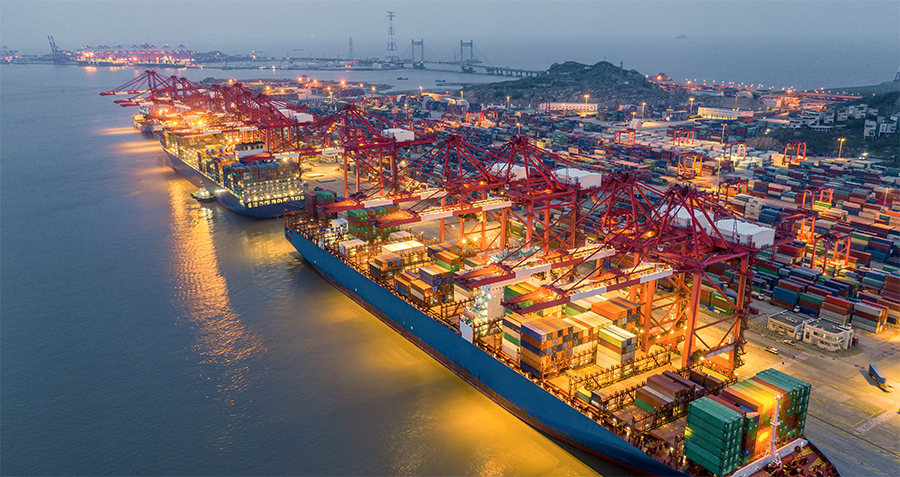As the world continues to battle the COVID-19 pandemic, leaders of organizations have had to determine a way forward through another challenge—what many reports claim to be an increasingly deglobalized world. Governments and business leaders are now reconsidering global supply chains, questioning alliances and highlighting national security concerns, while emphasizing the importance of domestic sourcing. After decades of increasing globalization in capital flows and trade, growing trends appear to be pointing in in the opposite direction.
In this interview, however, Anil K. Gupta explains how globalization is not dying but that it is evolving to become more multipolar. Competition will be not just between China and the US. Rather, it will likely become either a multi-way competition or a competition between alliances.
Gupta is the Michael D. Dingman Chair in Strategy, Globalization and Entrepreneurship and Distinguished Scholar-Teacher at the Smith School of Business, at the University of Maryland. Ranked by Thinkers50 as one of the “world’s most influential management thinkers,” he is also Chairman of China India Institute, a Washington DC-based research and consulting organization, and is widely regarded as one of the world’s leading experts on strategy, globalization and entrepreneurship.
One of the most significant trends in global affairs over the past few decades has been globalization, with China playing a significant role. What is your sense of the overall trend of globalization today and into the future? And what impact has the pandemic had on that trend?
To understand the trends in globalization, it’s useful to start from the first principles i.e., what is the meaning of the term “globalization”? From the early days of the study of globalization, this term has been defined as “integration” among nations. Integration is a multi-dimensional term and includes economic globalization, cultural globalization, political globalization, globalization of terrorism, globalization by the diffusion of viruses, etc.
Even the term economic globalization is itself multi-dimensional and includes trade in physical goods, trade in services, foreign direct investment, cross-border portfolio investments, diffusion of technologies and other types of know-how, and cross-border flows of data.
Over the last 2,000 years, trade in physical goods (spices, tea, silk, oil, coal, iron ore, and more recently manufactured goods) has constituted the primary channel for cross-border integration. This type of globalization is on a rapid glide-path to history. However, globalization per se is alive and well. In fact, it’s becoming more robust. What we are witnessing today is global integration by the flows of bits, not atoms. Welcome to the new era of digital globalization.
There are several drivers of the decline of trade in physical goods.
First, the commodities boom has come to an end. Fossil energy is being replaced by renewable energy. Thus, oil prices have declined sharply. Slowly, the world is also starting to consume fewer barrels of oil. A similar trend is underway in coal.
Second, the rise of wages in China and other emerging economies coupled with growing automation is reducing the importance of labor cost arbitrage.
Third, the rise of e-commerce and the resulting push for quick deliveries and cost efficiencies is resulting in a shift from long supply chains to short supply chains. This means more domestic or regional production rather than imports.
Fourth, the pandemic and the growing tensions between China and the US have led political leaders to place far greater emphasis on reducing supply chain risks and over-dependence for critical goods on foreign suppliers.
All of these trends appear secular and thus unlikely to reverse. Data on cross-border merchandise trade (as a ratio of global GDP) are telling. By this most important measure, merchandise trade started declining in 2009. This type of deglobalization long predates the US-China trade war initiated by former President Donald Trump or the current pandemic.
On the other side, cross-border data flows have been growing at over 50% per year for over 20 years. During the pandemic, this type of global integration almost certainly grew even faster. Just look at the explosive growth in cross-border scientific collaboration, cross-border messaging and cross-border education.
Extrapolating from a McKinsey study from a few years back, cross-border data flows today contribute more to global GDP than cross-border merchandise trade. Thus, I shed no tears at the decline of the older-type of globalization.
To what extent do you agree with the view that we are moving towards a polarized world? And what are the primary risks that you see in the future in this regard?
If we look solely at China and the US, then it would appear as if the world is indeed becoming polarized. However, it is important to remember that more than 60% of the world’s GDP resides outside of China and the US. And, about 85% of the world’s GDP resides outside China.
There is no evidence of polarization between a large number of major economies such as the US, Europe, Japan, India, Latin America, and Africa. Similarly, it’s hard to argue that China and Europe are growing farther apart from each other—economically. The same could also be said for China and Latin America, or China and Africa.
Thus, all this talk of growing polarization is the product of a very narrow and incorrect analysis. What’s happening today is not polarization, but the emergence of a more multipolar world.
In a multipolar world, competition will be not just between China and the US. Rather, it will be either a multi-way competition or it’ll be a competition between alliances. I think the latter scenario is much more likely. This makes it very important for the major powers such as China, Europe and the US, to start building a web of alliances. This is the type of Great Game that is currently under way, especially after Biden became the US President.
How do you see the balance between China and India developing over the next decade and what are the prospects for cooperation vs. competition?
At present, the relationship between China and India is the worst it has been since 1962 when the two countries went to war. Last year, in 2020, the two had a bloody border clash once again. Without going into the question of who was at fault, it would be correct to say that the level of trust between the two countries is extremely low. This is particularly true on the Indian side. As a result, last year, the Indian government banned a large number of Chinese apps and is also unlikely to permit purchases of Chinese telecom equipment by Indian operators. It is hard for me to see the situation changing anytime soon.
Until the pandemic, for the past 4-5 years, the Indian economy was growing faster than China. 2020 was a major setback for India but not for China. According to IMF projections, from 2021 onwards, India is again projected to grow faster than China. In short, the ratio gap between Chinese GDP and Indian GDP is expected to be smaller in 2030 than in 2020.
A major bottleneck for cooperation between the two economies is that China is much stronger than India in tradeable merchandise goods and India is much stronger than China in tradeable services. However, China is less open to services imports (e.g., software services) than India is to merchandise imports. Unfortunately, this factor also reduces the prospects for cooperation between the two economies. This was also the reason why India did not join RCEP, which focuses primarily on merchandise trade, not services trade.
There are those who say that to attain sustainable global prosperity, there needs to be a common world view shared by all—the West, China, India, Russia, Africa etc. How would you define “world view” in those terms and what do you see as the prospects of a consensus on fundamental aspects such as economics, technology and the environment?
This basic argument is nonsensical. If we talk about all of the dimensions that matter, there has never been a common world view—nor will there ever be one—among the major economies. Even a married couple doesn’t agree on everything.
For global prosperity, what matters is that there be enough of an agreement on some of the major dimensions, such as the climate crisis, control of terrorism and protection of intellectual property.
Global prosperity is often the outcome not just of agreements or cooperation but also competition. Imagine a hypothetical world where China and the US choose not to share any technologies with each other. This type of intense competition may actually lead to faster technology advancement by both countries, thereby giving a boost to global prosperity. In short, we need to interpret the value of a “common world view” in a sophisticated rather than simplistic manner.
How has the concept of social responsibility manifested itself in the pandemic, seen from the perspective of different cultures and societies? And to what extent has the experience of the pandemic shifted the attitudes of people with regard to social responsibility?
The pandemic has definitely resulted in an ideological shift in the mindset of corporate leaders in Europe and the US. Until recently, Milton Friedman’s notion that the corporate responsibility of companies is to maximize shareholder value still reigned supreme. Now, even the US Business Roundtable—which comprises the CEOs of the country’s biggest companies—has publicly embraced the notion of stakeholder capitalism, which is very different from stockholder capitalism.
This shift is also being fueled by the rise of “knowledge workers” as much more central to companies. These people are often more social responsibility minded. If companies want to attract and retain them, then they have to embrace social responsibility.
So far, it’s been mostly words. We have to see whether the actions will match the words. Overall, I am optimistic.
How important is technology in the new global strategic balance and what advantages do China and India bring in this new tech and AI dominated scenario?
Technology continues to evolve at an exponential pace. At present, some of the major revolutions that are underway pertain to AI, quantum theory, robotics, biotechnology, and space. Over the next 10 years, we’ll see the world change more than it has in the last 25 years. We’re living in very interesting times.
Overall, China is ahead of India in the technology dimension. Partly, this is due to China’s 5x larger economy as compared to India. But China also spends a much higher percentage of its GDP on R&D (2.5%) than India does (1%). That said, India is technologically much stronger than it looks. India excels at frugal innovation. For example, India was the first country after the US, Europe, and Russia to successfully send a Mars orbiter, that too on a tiny $79 million budget. So, India gets a much larger bang for its R&D dollars than other countries, including China.
There is also another difference between China and India. Most Silicon Valley technology companies (e.g., Google, Facebook, Twitter, etc.) are officially or unofficially blocked in China. However, they dominate the Indian market. All of these companies as well as many others (e.g., IBM, Adobe, Texas Instruments) have very large fundamental research labs in India but not in China. This is why one does not see large Indian tech giants in the same league as China’s Alibaba, Tencent, and Baidu. However, it’s important to keep in mind that India’s tech giants include Google India, Facebook India, IBM India, and so forth.
As a global strategy scholar, I can confidently say that what matters is whether there is cutting edge R&D taking place in the country, not whether this R&D is being done by domestic or foreign companies.
India is also a global powerhouse in certain segments of the pharma sector, such as in generic drugs and vaccines (including vaccines against Covid-19).
The Trump era saw a fraying of international frameworks and alliances. To what extent do you see it being possible for traditional structures, largely dominated by the US since the 1940s, being revived under the new administration?
As I noted earlier, we’re now smack in the middle of a multipolar world that will become even more multipolar in the future. In such an era, no country—be that China or the US–can dominate the world. Thus, national power will be much more a function of the power of one’s alliances. Trump was blind in terms of not realizing this reality and pursuing a strategy of going it alone.
In contrast, Biden has been explicit about the centrality of alliances in today’s environment. He has already started strengthening the existing alliances—such as with Europe and Japan—but also building new alliances.
In addition to alliances that are led by the US (such as NATO), Biden has also been very active in rejoining global platforms such as the WHO and the Paris Climate Accord. In my view, these are all very sensible moves.




















